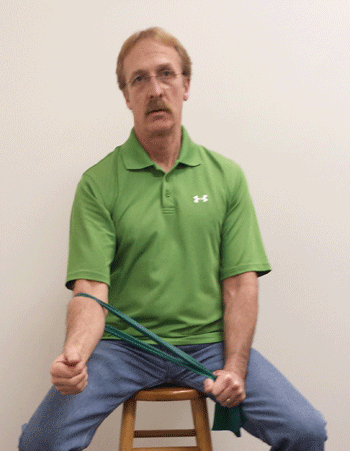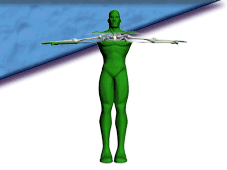The Best Exercises X
Band Elbow Sling Upstroke Or Downstroke
 The exerciser makes a loop, or sling, in the band by grasping the two ends in his left hand. The loop part
of the band wraps around the painful elbow about one inch below the joint with that elbow relatively
straight but not locked. The left hand is pulled enough to create tension and pull on the right elbow.
If the outside (lateral) part of the elbow is the problem the band is held downward with the left hand
while the right arm is pulled upward and clockwise (from exerciser's point of view). This movement
(shown here) is for classic tennis elbow. If the inside (medial) elbow were the problem (golfer’s elbow)
the band would be held upward in the left hand while the right arm is pulled downward and counter-
clockwise. In each case the contact of the band loop at the elbow should feel effective and "good" to
the exerciser, assuming that it is in the correct therapeutic location. The exercise is given 20 reps and
done as frequently as needed for relief.
The exerciser makes a loop, or sling, in the band by grasping the two ends in his left hand. The loop part
of the band wraps around the painful elbow about one inch below the joint with that elbow relatively
straight but not locked. The left hand is pulled enough to create tension and pull on the right elbow.
If the outside (lateral) part of the elbow is the problem the band is held downward with the left hand
while the right arm is pulled upward and clockwise (from exerciser's point of view). This movement
(shown here) is for classic tennis elbow. If the inside (medial) elbow were the problem (golfer’s elbow)
the band would be held upward in the left hand while the right arm is pulled downward and counter-
clockwise. In each case the contact of the band loop at the elbow should feel effective and "good" to
the exerciser, assuming that it is in the correct therapeutic location. The exercise is given 20 reps and
done as frequently as needed for relief.Band Reverse Arm-wrestle Pulls
 The exerciser rests his right elbow on the table as if preparing to arm wrestle. He holds each end of
the band in each hand. His left hand pins the band down to the table and in such a way that there
is a tension on the band which pulls the right hand toward the left. Then the right hand repeatedly
draws the band back in a reversed arm-wrestle move as the right elbow is kept stationary and fixed
on the table. These pulls are repeated until shoulder fatigue is reached. 3 sets are performed with a
one-minute rest between sets. The exercise is done once or twice daily. This exercise is the best at
strengthening two of the four rotator cuff tendons, and thus, stabilizing a painful shoulder.
The exerciser rests his right elbow on the table as if preparing to arm wrestle. He holds each end of
the band in each hand. His left hand pins the band down to the table and in such a way that there
is a tension on the band which pulls the right hand toward the left. Then the right hand repeatedly
draws the band back in a reversed arm-wrestle move as the right elbow is kept stationary and fixed
on the table. These pulls are repeated until shoulder fatigue is reached. 3 sets are performed with a
one-minute rest between sets. The exercise is done once or twice daily. This exercise is the best at
strengthening two of the four rotator cuff tendons, and thus, stabilizing a painful shoulder.Return to the Articles Page
Return to the Where's Your Pain? Page



